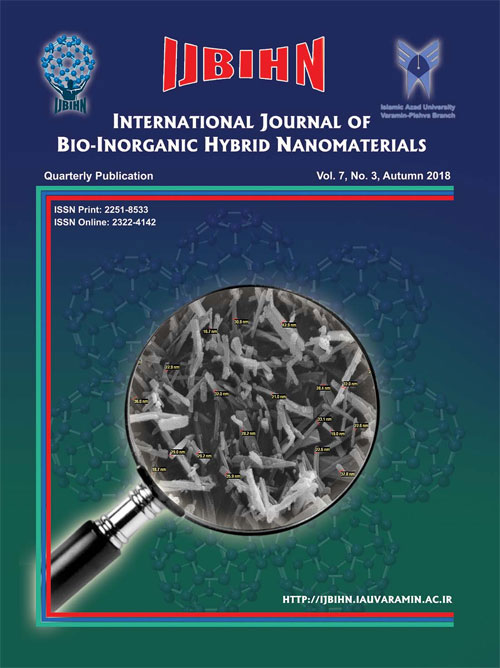فهرست مطالب

International Journal Of Bio-Inorganic Hybrid Nanomaterials
Volume:9 Issue: 3, Autumn 2020
- تاریخ انتشار: 1400/10/06
- تعداد عناوین: 6
-
Pages 123-129
In this paper we report upon the preparation and characterization of electrospun nanofibersof doped polyaniline (PANI)/poly(methyl methacrylate) PANI-PMMA/AgNO3 by electrospinningtechnique. At first, Doped polyaniline (PANI) was obtained by the polymerization of aniline using chemicaloxidative polymerization in the presence of ammonium peroxydisulfate (APS). The doped PANI wasdedoped by ammonia solution. Then, the electrospinning method was applied on the solutions involvingPANI-PMMA, PANI-PMMA-AgNO3. The as-prepared PANI-PMMA and PANI-PMMA-AgNO3 compositenanofibers were investigated for structural characterizations by means of SEM, FTIR and UV-VIS. SEMtechnique was used to investigate the morphology of the accumulated fibers or particles on the Alsurface collector. SEM revealed the nanofibers with the diameter Micro to nanofibers formed a nonwovenmaterial with highly porous and agglomerated structure. The presence of Ag in the case of Agcontaining composite nanofibers was confirmed by EDAX.
Keywords: Composites, Electrospinning, Nanofiber, Polyaniline, Poly(methyl methacrylate), SEM -
Pages 131-136
Chemical precipitation method was used in order to synthesize of ZnO quantum dots (2-3nm) and ZnO:Fe nanoflower. Their physical properties and characteristics were assessed by X-raydiffraction (XRD), ultraviolet-visible (Uv) spectrophotometer and Transmission Electron Microscope (TEM) and it was shown that the obtained ZnO:Fe quantum dots have a hhexagonal crystal structureof a high-quality. Antibacterial effects of ZnO:Fe nanoparticles against some pathogenic bacteriawere investigated. Staphylococci aurous and Escherichia coli were used as test microorganisms.Disc bacteriological tests were used in order to assess the effects of ZnO:Fe concentration (0.35 to6 mg/mL) as antibacterial. The magnetic field with nanoparticles with different concentrations of ironcontaminatedoxide has no effect on stopping the growth of Staphylococcus aureus and Escherichiacoli bacteria in the field. The sizes of inhibition zone were different according to the type of bacteria andthe concentrations of ZnO:Fe nanoflower, the maximum diameter being observed for Staphylococcusaurous.
Keywords: antibacterial effect, Escherichia coli, Quantum Dots, Staphylococci aurous -
Pages 137-142
In this research, the graft copolymerization of 2-hydroxy propyl methacrylate-acrylic acidmixture onto poly (ethylene terephthalate) fibers, in the presence of benzoyl peroxide as an initiator wasaccomplished. The Modified fibers were used as a new adsorbent for removal of cetyl pyridinum bromidefrom aqueous solution. The adsorption data were best fitted by Freundlich isotherm and pseudo firstorder kinetic models, as well. Thermodynamic parameters like enthalpy, entropy and Gibbs free energyhave been determined. The results were emphasized that, the adsorption process was unspontaneousand feasible.
Keywords: Acrylic Acid, Adsorption, 2-Hydroxy propyl methacrylate, Isotherm, kinetic -
Pages 143-148
A convenient synthesis of , n-benzoiel-1,3-diaryl-2-(para formyl) azaphenalene derivativesunder microwave irradiation as well as conventional thermal method using by a one-pot condensationreaction of the aromatic dial, 2,7naphthalenediol, carboxylic acids and aqueous ammonia (25 %) isreported. Microwave irradiation has resulted in the reduction of time from 10-20 min to a 1-2 minutes.
Keywords: 2-Azaphenalene, Microwave irradiation, One-pot, Thermal -
Pages 149-177
Given the high prevalence of acute and chronic diseases caused by unhealthy foodconsumption, design and development of accurate and sensitive sensors for the detection of foodcontaminates is importance. The appearance of nanotechnology and nanomolecular detection mathodsbased on aptamer-conjugated nanoparticles has made it possible to identify the lowest concentrationof risk factors in food at point. In this study we described an over review on the different types ofnanostructures used in the design of detection biosensors in the field of food safety assay. Nanostructuresand nanomaterials are the most important candidates for improving the sensitivity and LOD (Limit ofDetection) properties of biosensors due to their unique characteristics such as high surface-to-volumeratio and physicochemical and optical properties. Nanomaterials with high surface-to-volume ratio willprovide a large surface area for the loading of specific recognition element and will also have goodmolecular interaction with target molecules. Also, by using the optical and physicochemical propertiesof nanomaterials, these structures can amplify the optical and electrochemical signals generated inbiosensors that result from the interaction between the target molecule and its specific recognitionelement. Given that the design and development of high-precision and sensitive diagnostic biosensorsis crucial for identifying biomarkers, and various studies have shown that the use of nanostructuresdue to their structural and physical properties can play an important role in improving the biosensorproperties.
Keywords: Aptasensors, Food Safety, Hybrid Nanomaterials, Point of Care, Smartphone -
Pages 179-193
There is considerable interest in using nano-emulsions (NEs) as delivery systems forlipophilic bioactive ingredients. In this study, we investigated the influence of propylene glycol (PG)on the properties of VE enriched NEs prepared using the spontaneous emulsification (SE) method.The particle size and optical clarity of the NEs depended strongly on the co-solvent concentration.The smallest droplets (mean diameter less than 23.5, and 262.96) and highest transparency (lowestturbidity, 0.0069 cm-1, and 0.023 cm-1) were observed in the absence of the PG (A formulation) and thepresence of 10 wt.% PG (B formulation), respectively. However, these NEs were highly unstable todroplet growth during storage, especially at high temperatures, which was attributed to coalescenceand Ostwald ripening. Dilution of the NEs (100× with water) before storage considerably improvedtheir storage stability, especially at higher storage temperatures. Undiluted NEs exhibited a sharp andirreversible increase in turbidity upon heating: ≈75 °C and 50 °C for the systems in A formulation andB formulation, respectively. Diluted NEs had much better thermal stability, with a sharp increase inturbidity occurring at ≈75 °C for these systems. This study provides useful information for use in thepharmaceutical, foods, and beverages industries.
Keywords: Co-solvent, Dynamic Light Scattering, Nano-emulsion, Spontaneous emulsification, propylene glycol, vitamin E

